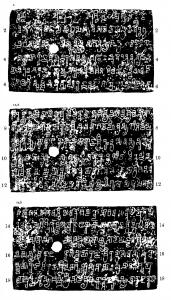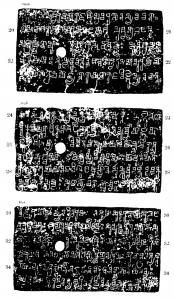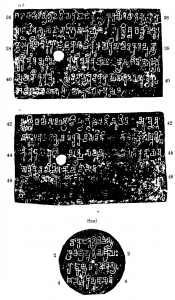


The charter was issued by Pravarasena II in the 27th year of his reign and is, according to Shastri 1963: 31, a unique charter in the Vākāṭaka examples because it provides for a free feeding house, attached to a temple as opposed to an individual donation of a land grant. The donation was made at the request of Nārāyaṇarāja.
Seen Hail! From Prvarapura―
By the order of the illustrious Pravasēna (II), the Mahârâja of the Vâkâtakas, and a devout worshipper of Mahêśvara, who, by the grace of Śambhu, has established the Kṛitayuga (Golden Age) (on the earth), who was born of Prabhâvatîguptâ, the daughter of the Mahârâjâdhirâja, the illustrious Dêvagupta, (and) who is the son of the illustrious Rudrasêna (II), the Mahârâja of the Vâkâtakas―
(for translation of lines 1-16, see above, pp 13-14)
(The residents of) the village led by the Brâhmanas m Aśvatthakhêtaka m the mârga of Varadâkhêta (included) in the bhôga of Lôhanagara, should be addressed as follows―
In this village We have donated, at the request of Nârâyaṇarâja, four hundred mvartanas of land by the royal measure, to be utilised for the charitable feeding house (attached to the temple of) Mahâpurusha (Vishnu)
(for translation of lines 24-39, see above, pp 14-15 and p 32)
(Line 39) And the following two verses sung by Vyâsa should be regarded as authoritative on this point―
(Here occur two benedictive and imprecatory verses)
(Line 43) (This charter has been) written by Kâlidâsa, a servant of the Sênâpati Kâtyâyana on the seventh (lunar day) in the dark fortnight of kârttika m the twenty-seventh (regnal) year. (It has been) engraved by the goldmith Îśvaradatta, a servant of Kaunḍarâja. The executors of this (royal) charter are Pitâmaha and Nanda.
Seal
(For translation of the legend on the seal, see above, p 27)